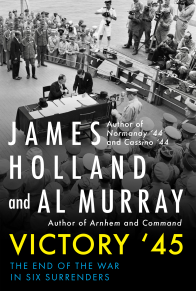“While the invasion’s first wave consumes half the book’s ammunition, Mr. Holland holds plenty in reserve for the Allied crawl through hedgerow country, the battle with Hitler’s panzers at Caen, the brilliant breakout of Operation Cobra seven weeks after D-Day, and the corpse-strewn German retreat through the Falaise Gap . . . Detail and scope are the twin strengths of Normandy ’44 . . . Mr. Holland effectively balances human drama with the science of war as the Allies knew it.”—Jonathan W. Jordan, Wall Street Journal
“A superb account of the invasions that deserves immense praise . . . To convey the human drama of Normandy requires great knowledge and sensitivity. Holland has both in spades.”—Times (UK)
“Any brief analysis of an undertaking of this size cannot do justice to Holland’s impressive organization of facts, figures and details . . . Every detail is scrupulously referenced . . . As an account of this mighty and vitally significant clash of armies on many battlefields Normandy ’44 stands as richly impressive, hard to surpass.”—William Boyd, Times Literary Supplement
“Describes with exhilarating pace and detail where the contents of all those rural Hampshire depots and tank parks ended up between early June and late August in 1944. This may sound like a story you have heard and seen before, but this version—even though the outcome is familiar—contains an ingredient too infrequently found in history books: it is exciting . . . Adrenaline flows here from a thrilling sense of being close to the people making the decisions, firing the weapons, and witnessing enemy tanks come rumbling around a corner.”—Strong Words Magazine
“Holland has a brisk style that effortlessly combines narrative history with combat memoirs from both sides, creatively balancing the general’s and sergeant’s points of view of the daily grind of close quarters combat . . . Highly readable . . . Well written and illustrated, with some outstanding maps, his book really does a marvelous job of showing the significance of D-Day in the Great Crusade to liberate Europe and defeat Nazi Germany.”—New York Journal of Books
“This hefty, scrupulously balanced history of the Allied invasion of northern France goes beyond some of the well-known events of D-Day, thanks to Holland’s meticulous research and clear-eyed view of the big picture . . . An excellent and engrossing new look at the Normandy invasion.”—Publishers Weekly (starred review)
“Holland thoroughly describes the tactical events leading up to and immediately following D-Day, as well as the many challenges, mistakes, and myths surrounding the battle itself. Personal narratives from both Allied and German officers and air and ground troops, along with technical descriptions of weapons manufacture and use, provide an absorbing perspective on one of the most significant events in modern military history. Meticulous attention to detail combined with a conversational writing style make this World War II chronicle accessible for most general readers.”—Library Journal (starred review)
“Holland’s reappraisal of the battle of Normandy will take its rightful place, with earlier accounts by Stephen E. Ambrose, Max Hastings, and others, at the head of the platoon . . . Offers a strikingly personal and, at times, horrifically vivid recounting of the various campaigns and the appalling carnage they produced . . . From Omaha Beach to the Falaise Gap, this is thoughtful, crisply written military history.”—Booklist
“Veteran military historian Holland knows the drill but doesn’t hesitate to wander from the script . . . A skillful writer, Holland delivers the occasional jolt, such as a mild rehabilitation of Field Marshal Bernard Montgomery. Even contemporaries criticized his careful preparation and slow advances, but the author points out that this took maximum advantage of superior Allied resources and saved lives. Far from the first but among the better histories of the Allied invasion of Europe.”—Kirkus Reviews
“[A] major new history . . . A comprehensive look at less sensational or dramatic aspects, such as the economics and logistics of war.”—Lenny Picker, Publishers Weekly
Praise for James Holland:
“Highly detailed . . . The interplay of personal stories with the broader strategic picture makes this book especially illuminating . . . A fascinating must-read for World War II aficionados.”—Kirkus Reviews (starred review) on Big Week
“James Holland’s The War in the West is set fair to become one of the truly great multivolume histories of the Second World War.”—Andrew Roberts, New York Times-bestselling author of The Storm of War: A New History of the Second World War and Napoleon: A Life
“A fascinating story of how the fortunes of war changed in obvious—and particularly not so obvious—ways.”—Col. Eric M. Walters, Military Review on The Allies Strike Back
“Holland puts the case for Allied technological and military skills as a vital factor in turning the war’s tide . . . Ranks as a towering work of historical research and writing.”—BBC History Magazine on The Allies Strike Back
“This is narrative history as intimate, intricate tapestry . . . Mr. Holland’s success is built in part on an engaging writing style and in part on a genuinely fresh approach to events that have been so often—and apparently definitively—recounted . . . Exceptional . . . Epic.”—Wall Street Journal on The Rise of Germany
“Impeccably researched and superbly written . . . Holland’s fascinating saga offers a mixture of captivating new research and well-considered revisionism.”—Guardian on The Rise of Germany
















